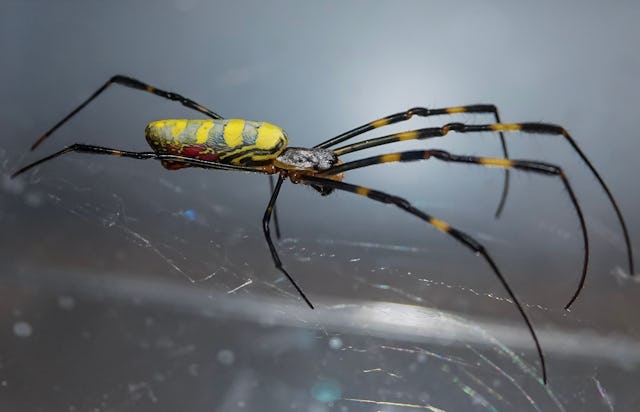WTF Is Up With The Huge, Venomous “Flying” Spiders Invading The East Coast?
The Joro spider looks like straight-up nightmare fuel, but it's harmless — swear.

As we recover from cicada season, another invasive insect species is making its presence known along the East Coast of the United States, and this one might have arachnophobes hiding in the safety of their homes. The Joro spider — a large, venomous yellow spider native to East Asia — is expected to colonize several U.S. states soon, which means you might need to get comfortable with the prospect of seeing these colorful arachnids and their massive webs around town.
Where are Joro spiders from?
According to the Boston Globe, the yellow-bodied Trichonephila clavata (Joro spider) is native to Asian countries, including Japan, China, Taiwan, and Korea. Turns out, at least one hitched a ride on a shipping container from Southeast Asia, landing in Georgia around 2014, which means some southern states have had them around for over a decade.
Now, experts note they are popping up in several states, with sightings in Alabama, Florida, Georgia, Kentucky, Mississippi, North Carolina, South Carolina, Tennessee, Virginia, West Virginia, and Ohio. Northerners are not out of the woods, because experts believe they'll make their way to New York, New Jersey, and even Canada later this year. They're migrating north since they're better suited to colder climates, which might make you feel better or worse depending on where you live and how afraid you are of big, colorful, creepy crawlies.
How big are Joro spiders?
With everyone describing these arachnids as “huge” and “giant” (guilty as charged), you may be imagining something straight out of a sci-fi movie. And, admittedly, they are pretty damn big — the bodies of adult female Joros measure up to an inch long with a leg span of up to four inches, according to Penn State Extension. Adult male Joros are considerably smaller, clocking in with a body length of just over a quarter of an inch.
For context, a standard U.S. soda can is 4.8 inches high with a diameter of 2.6 inches. So, the female Joro spider would be slightly smaller than your can of Diet Coke.
Their webs, on the other hand, are massive, with some reports putting them at up to 10 feet wide.
Can Joro spiders fly?
Contrary to popular belief, the Joro spider cannot fly, though you still might see some take to the skies. As David Coyle, an assistant professor of forest health and invasive species at Clemson University in South Carolina, told the Boston Globe, tiny spiderlings (roughly the size of a sesame seed) begin "ballooning" after they hatch, putting out a few strands of silk at a high location.
"And if they're lucky, the wind catches them," carrying them away, per Coyle. "All orb-weaving spiders do this," he said. "Every spring, there's spiders ballooning over us, and we have no idea."
Only babies do this because "as they get larger, they're just way too heavy to be able to balloon," Coyle told the outlet.
They can also survive a wide range of conditions, with Andy Davis, a research scientist at the Odum School of Ecology at the University of Georgia, telling NBC News why you might see them near your house, at a gas station, or on traffic lights.
"Joro spiders seem perfectly content with living on a gas station pump in addition to living in a tree in the forest," he said. "If they can live in these disturbed areas just as much as they can live in natural areas, that means there's nothing stopping them from living anywhere in this country." (Lovely, right?)
How venomous is the Joro spider?
Almost all spiders, including the Joro, are venomous. Still, it might give you some small comfort to know that these babies are "very shy," as Gustavo Hormiga, a professor of biology at George Washington University, told NBC News. In fact, they are relatively harmless to people and pets (so please cross "Can Joro spiders kill humans?" off your list of questions), though they are certainly invasive to other pests, such as mosquitoes, flies, and crop-killing stink bugs.
OK, but do Joro spiders bite? They do, but it seems you're more likely to get caught in their 10-foot webs than to experience a health emergency from a Joro spider bite.
"For a really big spider, they're going to have big enough fangs and strong enough jaws to puncture the skin," David Nelsen, a professor of biology at Southern Adventist University in Tennessee, told the Boston Globe. "They're not dangerous because the venom is really, really insect-specific, and we're not insects."
"If you touch their web, their first reaction is to run away or drop down to the ground and curl up into a ball and play dead," he added. They'll typically only bite if they're feeling threatened.
What should you do if you see them?
The Joro spider has a short lifespan. Its eggs hatch in the spring, grow in the summer months, and mature into large spiders with yellow, silver, blue, black, gray, or red stripes by September or October. It's the adult females that are large and vibrant, growing to roughly 3.5 inches across, while males are smaller and duller in hue.
"Pesticides work, but they are also probably overkill because it will kill everything else, and there is a cost involved," Coyle told CBS News. "They seem to love structures. So, I just tell people to take a stick or broom and remove them."
He added, "People should try to learn to live with them. If they're literally in your way, I can see taking a web down and moving them to the side, but they're just going to be back next year."
For the record, I will judge you 0% if you scream and run away, but at least you can rest easy knowing your kids and pets are probably safe from these large, leggy creatures.